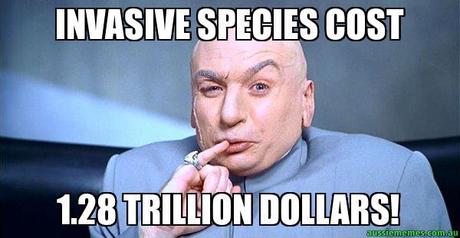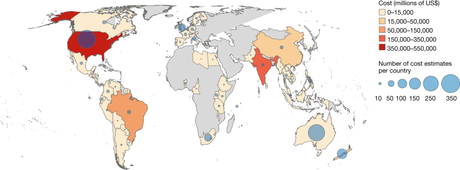
Or thereabouts.
Let’s step back to 2015. In a former life when I was at another institution, I had the immense fortune and pleasure to spend six months on sabbatical in a little village just south of Paris working with my friend and colleague, Franck Courchamp, at Université Paris-Sud (now Université Paris-Saclay).
Sure, I felt a bit jammy living there with me daughter in a beautiful house just down the street from two mouth-watering pâtisseries and three different open marchés. We ate well. We picked mushrooms on the weekends or visited local châteaux. We went into the city and visited overwhelmingly beautiful museums at our leisure. We drank good champagne (well, I did, not my eight-year old). We had communal raclettes.
But of course, I was primarily there to do research with Franck and his lab, despite the obvious perks.
While I busied myself with several tasks while there, one of our main outputs was to put together the world’s first global database of the costs of invasive insects, which we subsequently published in 2016.
But that was only the beginning. With funding that started off the process with insects, Franck persevered and hired postdocs and took on more students to build the most comprehensive database of all invasive species ever compiled — InvaCost.
I cannot stress enough how massive an undertaking this was. It’s not simply a big list of all the cost estimates in existence, it’s also a detailed assessment of cost reliability, standardisation, and contextualisation. I’m not sure I would have had the courage to do this myself.
While the database itself has already been published, today we are pleased to announce the publication in Nature of the main results — High and rising economic costs of biological invasions worldwide — led by Christophe Diagne (one of the nicest people I’ve ever met), and co-authored by Boris Leroy, Anne-Charlotte Vaissière, Rodolphe Gozlan, David Roiz, Ivan Jarić, Jean-Michel Salles, me, and Franck Courchamp (of course).
Herein we described how the economic costs of invasive alien species accumulated since 1970 are tremendous, and that they have been steadily increasing over time.
In fact, the total cost has been trebling every decade for three, main reasons:
(1) the ongoing intensification of global trade and transport creating more opportunities for invasions to occur;
(2) the expansion of agriculture and infrastructure that make societies increasingly sensitive to impacts from invasions; and
(3) increasing awareness and reporting of the economic impacts arising from invasions.
One of the most illustrative examples of such species is the group of invasive rodents such as the black rat (Rattus rattus), the coypu (Myocastor coypus), and the house mouse (Mus musculus). These small mammals have many detrimental impacts, including the decline and extinction of native species on many islands worldwide, the spread of infectious diseases, and the consumption of crops and stored foods. All these have high economic consequences for humans. For instance, annual agricultural losses attributed to rodents have been assessed at US$1.9 billion in Asia alone.
Other examples include the health costs from the tiger mosquito (Aedes albopictus) and the common ragweed (Ambrosia artemisiifolia), such as medical care, loss of productivity and income for ill patients. Other examples include the brown tree snake (Boiga irregularis) in Hawai’i that damages infrastructure and the voracious fall armyworm (Spodoptera frugiperda) that attacks more than 80 crop species of high nutritional and socio-economic utility in 45 African countries.

But no database of this nature will ever be complete, and this is one reason why the publicly available InvaCost is a ‘living’ database that will constantly be updated. As such, our latest study relies on costs recorded on the original version of the InvaCost database, which is clearly not exhaustive. Indeed — the latest version now has ~ 10,000 entries.
Also, our reported costs still clearly represent an underestimate of the actual economic burden of invasive alien species, because as we found for insects, the more you look (i.e., more studies), the higher the estimates become.
While we ensured robust data pre-processing prior to analysis, the quality and reproducibility of studies reporting costs are variable. Therefore, the cost estimates we report should be considered in terms of relative orders of magnitude rather than precise values.
It’s also worth mentioning that a 2010 IUCN report indicated that invasive species cost more than a trillion dollars annually. But that report relied on a deeply flawed paper that failed to vet the estimates it included (many of them largely just speculated or made up entirely). So, our more conservative approach amplified the inherent underestimation associated with invasion costs.
In fact, had we used a less-stringent approach for our data selection, our estimates would have blown out by 33 times to > US$5.4 trillion for 2017 alone.
So, while there will always be more work to do here, suffice it to say that we spend a shit-tonne of money on the consequences of invasive species than we should have to. And who actually pays? Well, it’s poor sods like me and you in terms of health costs and rising prices of goods and services affected by invasive species.
One last note — look out for a special issue of the journal NeoBiota coming out in the next few months that includes papers examining the finer-scale, regional patterns of costs arising from invasive alien species. I’m leading the one focussing on Australian therein.

